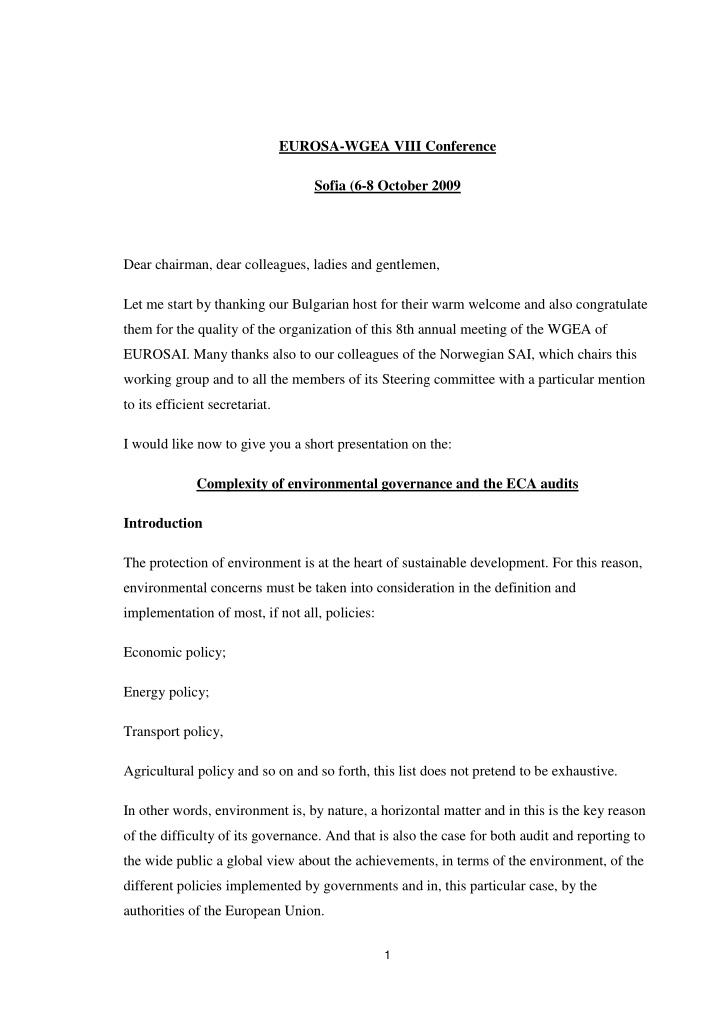



EUROSA-WGEA VIII Conference Sofia (6-8 October 2009 Dear chairman, dear colleagues, ladies and gentlemen, Let me start by thanking our Bulgarian host for their warm welcome and also congratulate them for the quality of the organization of this 8th annual meeting of the WGEA of EUROSAI. Many thanks also to our colleagues of the Norwegian SAI, which chairs this working group and to all the members of its Steering committee with a particular mention to its efficient secretariat. I would like now to give you a short presentation on the: Complexity of environmental governance and the ECA audits Introduction The protection of environment is at the heart of sustainable development. For this reason, environmental concerns must be taken into consideration in the definition and implementation of most, if not all, policies: Economic policy; Energy policy; Transport policy, Agricultural policy and so on and so forth, this list does not pretend to be exhaustive. In other words, environment is, by nature, a horizontal matter and in this is the key reason of the difficulty of its governance. And that is also the case for both audit and reporting to the wide public a global view about the achievements, in terms of the environment, of the different policies implemented by governments and in, this particular case, by the authorities of the European Union. 1
I the complexity of the environment governance This Complexity results from three main reasons: a) Probably, we have to start saying that the integration of environmental aspects in a specific policy constitutes almost systematically an element of complication for those who have to manage it. For instance, in the new framework of the Common Agricultural Policy (CAP) there are Cross compliance measures in order to protect the environment which create a real bulk of work for the management authorities in terms of controlling the good agriculture practices and environmental conditions. b) Secondly, in budgetary terms, environment is linked with an extra cost for public budget and a smaller grants for beneficiaries, which means resistance; c) Finally, protection of the environment could be or could appear, at least in short terms, contradictory with other objectives followed by the same policy. For instance, the objective of competittivity and environment when the last one means extra cost, longer time and a more complicated implementation. II the complexity of the environment auditing Since 1992, the European Community (EC) has put in place, specific financial tools, the Life programs, which are fully devoted to the protection of environment and biodiversity. I should say that the level of complexity of this tool, is similar to other audit areas. Actually, the difficulties come mainly from the projects’ management themselves and the different profiles of the beneficiaries. I take the opportunity, to inform you about the recent publication of the Special report 11/2009 of the Court for which Mr. Kazamias was the reporting member and my colleague and friend Armando Do Jogo the team leader. Armando presented this report with title “Sustainability and Commission management of Life-nature projects” in the seminar held last Monday 5 th October. Of course, I cannot but invite all of you to read this very good peace of work On the contrary, for the other EC policies which, as I said above, most of them include the 2
protection of the environment among other objectives, auditors meet two set of difficulties. The first one is comparable to those to which managers are confronted but translated in audit terms. The second one, comes from the organization of the European Court of Auditors (ECA) Audit difficulties comparable to the governance ones a) Audit risks are linked with the complexity b) audit work needs examination and analysis of the functioning of several administrations involved and management procedures applied; c) audit criteria, since there are various targets, criteria or parameters used to measure the achievements and impacts should be numerous as well. (Control of the CO2 gas emission, quantity of pesticides, sustainability of species etc). Complexity as a result of the organization of the ECA The ECA, as you may know, is structured in five groups. One, horizontal group is in charge of the coordination of the work DAS, of methodology tools and communication and four vertical audit groups. Each one of these is responsible of the audit area corresponding to those defined in the multi-annual financial perspectives and in its duties is supported by audit units. Therefore, when the policy, or financial tool, to be audited gets a specific budget and legal framework and is implemented under the responsibility of a general direction of the Commission or by shared management with Member States, the audit group one of the Court does not meet particular difficulties to organize its audit. On the contrary, when the Court wants to carry out a comprehensive audit of a horizontal theme like, for instance, “EU policy of protection of the water quality”, it faces great difficulties to deal with. Actually, the implementation of such a task needs the cooperation of, at least, two audit groups of the Court. In the example chosen, the Audit group 1 is in charge of auditing several areas affected by water questions, for instance cross compliance, agri- 3
environment, Life environment, fisheries, and protection of the Consumers. As; the Audit group 2, is in charge of auditing the cohesion policy, financed through the structural funds, and has in its portfolio, tasks on waste water treatment plants, water supply etc). In few words dealing with horizontal audits tasks means a real and difficult challenge for an audit organization based on a vertical logic. However, in its Audit strategy, for the period 2009-2013, the ECA has decided to face this challenge and has identified two cross cutting themes “Environment, health and consumer protection and has adopted a pragmatic approach in order to carry out two horizontal audits during this period. Thank you very much for your attention 4
Recommend
More recommend